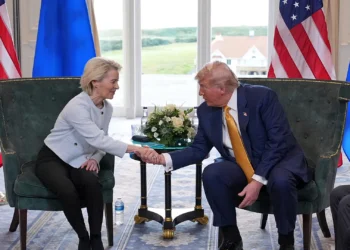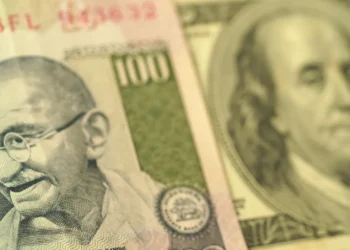TURNBERRY (Realist English). The United States and the European Union have reached a long-anticipated trade agreement that will avert a full-blown transatlantic trade war, while still imposing a 15% US tariff on most European exports — including cars, pharmaceuticals, and semiconductors.
The agreement was sealed during a meeting on Sunday between President Donald Trump and European Commission President Ursula von der Leyen at Trump’s Turnberry resort in Scotland. It follows months of escalating tensions and tariff threats from Washington.
In exchange for reduced tariffs on some key sectors, the EU has pledged to spend hundreds of billions of dollars on American energy products and military equipment, as well as invest heavily in the US economy. Trump hailed the outcome as “probably the biggest deal ever reached in any capacity, trade or beyond trade.”
According to the deal’s terms, the EU will spend $250 billion annually for the next three years on US energy, and invest $600 billion in the American economy, while purchasing what Trump described as “a vast amount” of US-made defense systems. Overall, the EU’s total commitment to American energy and arms exceeds $750 billion.
Von der Leyen confirmed that the 15% tariff would apply to major European exports—a sharp reduction from the 27.5% previously levied on EU carmakers—but acknowledged that it would be “a challenge for some industries.” She added, “Today’s deal creates certainty in uncertain times, for citizens and businesses on both sides of the Atlantic.”
However, the US will maintain higher tariffs on European steel and aluminum, currently at 50%, dashing hopes of broader relief for heavy industry.
Markets responded positively: the Euro Stoxx 50 futures index rose 1% and the euro edged up 0.1% against the dollar in early Monday trading.
German Chancellor Friedrich Merz welcomed the deal as a relief, saying it “avoids an unnecessary escalation” and protects Germany’s export-heavy economy. The cut in US car tariffs was particularly significant for Germany’s auto sector.
Yet business leaders voiced concern over the long-term costs. Wolfgang Niedermark, board member of the Federation of German Industries (BDI), described the agreement as “an inadequate compromise,” warning that the 15% tariff “will have a huge negative impact on Germany’s export-oriented industry.”
Italian Prime Minister Giorgia Meloni, who had previously urged restraint, praised the outcome, stating that Europe “avoided the trap of those who sought a head-on clash between the two sides of the Atlantic.”
The European Round Table for Industry, representing top CEOs from the continent’s leading firms, expressed cautious support, calling for follow-up negotiations in sectors still subject to potential US tariffs—such as aerospace.
Ahead of the meeting, Trump repeated his long-held criticism of the EU’s trade surplus with the US, which reached nearly €200bn last year, calling the relationship “unfair” and “one-sided.” Von der Leyen conceded that the imbalance required “rebalancing.”
Despite the breakthrough, uncertainty remains. The Trump administration continues to investigate European aerospace, pharmaceutical, and semiconductor exports, raising the possibility of future tariffs. A senior US official said it was “likely” aerospace products would be spared, but declined to rule out new levies entirely.


















